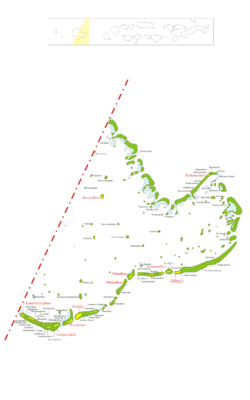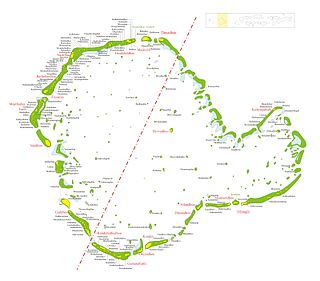
Huvadhu is a large atoll located south of the Suvadiva Channel the Republic of Maldives. Etymologically it was called Suvadhinmathi or Suvadiva, with a total area of 3152 km², of which 38.5 km² is dry land. The atoll contains 255 islands, the most in the Maldives.

The Maldives are formed by 26 natural atolls, along with a few islands and isolated reefs today which form a pattern stretching from 7 degrees 10′ North to 0 degrees 45′ South. The largest of these atolls is Boduthiladhunmathi, while the atoll containing the most islands is Huvadhu.
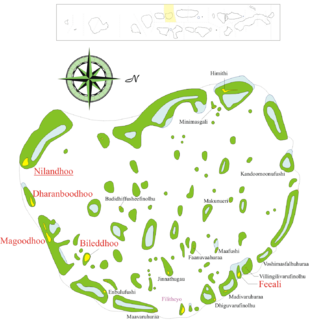
Faafu Atoll is an administrative division of the Maldives.

Haa Alif Atoll - officially referred as Thiladhunmathi Uthuruburi is the northernmost administrative division of the Maldives.
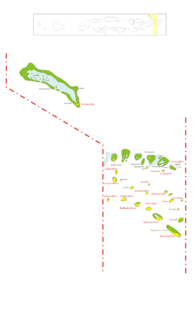
Haa Dhaalu Atoll is the code name based on the letters of the Maldivian alphabet commonly used to refer to the administrative division officially known as South Thiladhunmathi Atoll in the Maldives.

Noonu Atoll is an administrative division of the Maldives corresponding to the southern section of Miladhunmadulu Atoll. The capital is Manadhoo. Total population of Noonu Atoll is around 10,000 people.
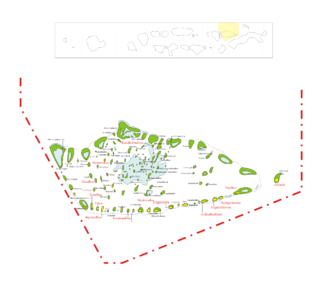
Raa Atoll is an administrative division from the Maldives. The capital is Ungoofaaru. It includes Northern Maalhosmadulu Atoll proper and the island of Alifushi.

Baa Atoll is an administrative division of the Maldives. It consists of three separate natural atolls, namely southern Maalhosmadulu Atoll, the Fasdūtherē Atoll and the smaller natural atoll known as Goifulhafehendhu Atoll.
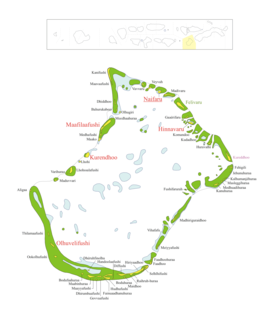
Lhaviyani Atoll is an administrative division of the Maldives. Its abbreviation is Lh.

Vaavu Atoll is an administrative division of the Maldives, comprising the natural atolls of Felidhu Atoll and the Vattaru Reef.

Mulaku Atoll or Meemu Atoll is an administrative division of the Maldives. It corresponds to the natural atoll of the same name, also known as Mulak Atoll or 'Mulakatolhu'.

Gaafu Dhaalu is an administrative district of the Maldives formed by the southwestern section of Huvadhu Atoll. It was created on February 8, 1962 when Huvadhu Atoll was divided into two districts. Gaafu Dhaalu corresponds to the Southwestern section of this large natural atoll, south of the line extending between the channels of Footukandu and Vaarulu Kandu. The capital of this region was Vaadhoo but it has been changed to Thinadhoo. There are 153 islands in this district, 10 of which are inhabited. This district is located about 340 kilometres south of the capital Malé.

Gnaviyani Atoll is one of the administrative divisions of the Maldives corresponding to the natural atoll, Fuvahmulah. Surfacewise this is the smallest administrative unit in the Maldives, situated in the Equatorial Channel between Huvadhu Atoll and Addu Atoll.
Vaadhoo is one of the inhabited islands of Southern Huvadhu Atoll, in the Gaafu Dhaalu Atoll administrative division.
Dhevvadhoo or Devvadū is one of the inhabited islands of the administrative division known as Northern Huvadhu Atoll.
Kondey or Kondē is one of the inhabited islands of Northern Huvadhu Atoll, administrative code Gaafu Alifu.
Villingili is one of the inhabited islands of Gaafu Alif Atoll.
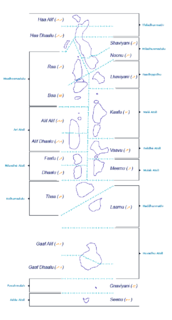
The Administrative Divisions of the Maldives refers to the various units of government that provide local government services in the Maldives. According to the Decentralization Act 2010, the administrative divisions of the Maldives would consist of atolls, islands, and cities; each administered by their own local council, under the basic terms of home rule. Geographically, the Maldives are formed by a number of natural atolls plus a few islands and isolated reefs which form a pattern from North to South. Administratively, there are currently 189 islands, 17 atolls and 4 cities in the Maldives.
Gan is one of the uninhabited islands of Southern Huvadhu Atoll, in the Gaafu Dhaalu Atoll administrative division of the Maldives and is the largest natural island in Huvadhu Atoll.
Kooddoo or Koodoo is one of the inhabited islands of Gaafu Alif Atoll, in the Maldives.

